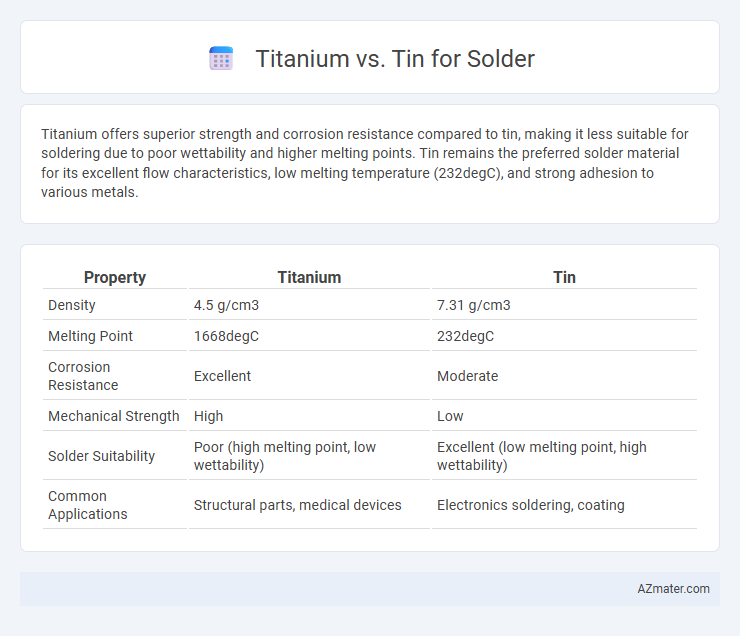Titanium offers superior strength and corrosion resistance compared to tin, making it less suitable for soldering due to poor wettability and higher melting points. Tin remains the preferred solder material for its excellent flow characteristics, low melting temperature (232degC), and strong adhesion to various metals.
Table of Comparison
| Property | Titanium | Tin |
|---|---|---|
| Density | 4.5 g/cm3 | 7.31 g/cm3 |
| Melting Point | 1668degC | 232degC |
| Corrosion Resistance | Excellent | Moderate |
| Mechanical Strength | High | Low |
| Solder Suitability | Poor (high melting point, low wettability) | Excellent (low melting point, high wettability) |
| Common Applications | Structural parts, medical devices | Electronics soldering, coating |
Introduction to Titanium and Tin in Soldering
Titanium and tin are both key materials in soldering, with tin serving as the primary metal in most solder alloys due to its excellent wetting properties and low melting point around 232degC. Titanium's role is more specialized, often used as an alloying element or coating to enhance corrosion resistance and mechanical strength in solder joints. Understanding the distinct metallurgical characteristics of titanium and tin helps optimize solder formulations for improved durability and performance in electronic assemblies.
Key Properties of Titanium vs Tin
Titanium offers superior corrosion resistance and strength compared to tin, making it ideal for high-stress or high-temperature soldering applications. Tin excels in electrical conductivity and melting point, ensuring efficient solder flow and strong electrical connections in electronic circuits. The choice between titanium and tin solder depends on the specific requirements for durability and conductivity in the intended application.
Melting Point Comparison
Titanium has a melting point of approximately 1,668degC, significantly higher than tin, which melts at about 232degC. This stark difference makes tin more suitable for soldering applications due to its low melting temperature, allowing for easier and safer joining of electronic components without damage. Titanium's high melting point limits its use in solder, as it requires much higher temperatures that can compromise delicate parts.
Electrical Conductivity Differences
Titanium exhibits significantly lower electrical conductivity compared to tin, making it less suitable for solder applications where efficient electrical flow is critical. Tin's high conductivity, approximately 9.17 x 10^6 S/m, ensures minimal resistance and optimal signal transmission in electronic joints. This disparity in electrical properties underpins tin's dominance in solder materials, as titanium alloys can introduce unwanted resistance and potential heat dissipation challenges in circuits.
Corrosion Resistance Analysis
Titanium exhibits superior corrosion resistance compared to tin in solder applications, due to its stable oxide layer that protects against oxidation and chemical degradation. Tin is more prone to oxidation and white corrosion, especially in humid or acidic environments, which can compromise solder joint integrity. Selecting titanium as a solder material enhances the longevity and reliability of electronic components exposed to corrosive conditions.
Mechanical Strength and Durability
Titanium solder alloys offer superior mechanical strength and enhanced durability compared to traditional tin-based solders, making them ideal for high-stress applications. The inherent tensile strength of titanium allows joints to withstand greater mechanical loads and resist deformation over time. Tin solder, while providing excellent electrical conductivity and ease of use, lacks the robustness of titanium, leading to potential fatigue and failure in demanding environments.
Soldering Process Compatibility
Titanium exhibits poor soldering process compatibility due to its strong oxide layer and low wettability with common solder alloys, requiring specialized fluxes and higher temperatures to achieve bond strength. In contrast, tin offers excellent solderability with a wide range of solder alloys, enabling efficient wetting and reliable joint formation at standard soldering temperatures. The compatibility of tin with traditional soldering processes makes it the preferred choice for applications demanding ease of assembly and consistent solder joint quality.
Applications in Electronics and Industry
Titanium exhibits superior corrosion resistance and strength in harsh environments, making it ideal for high-reliability electronic components and aerospace industry applications. Tin offers excellent solderability and electrical conductivity, widely used for circuit board assembly and consumer electronics manufacturing. The choice between titanium and tin for solder depends on required mechanical durability and environmental conditions in electronics and industrial sectors.
Cost and Availability Considerations
Titanium soldering materials are generally more expensive due to limited production and specialized manufacturing processes, whereas tin-based solders remain cost-effective and widely available for electronics and plumbing applications. Tin's abundance and established supply chains ensure consistent availability, making it the preferred choice for mass production and consumer electronics. The higher cost and limited accessibility of titanium solder restrict its use to niche applications requiring exceptional strength and corrosion resistance.
Which Is Better: Titanium or Tin for Solder?
Titanium is rarely used as a solder material due to its high melting point and poor wettability, making tin the preferred metal for soldering applications because of its excellent flow characteristics and lower melting point around 232degC. Tin-based solders, often alloyed with lead, silver, or copper, provide strong, reliable joints with good electrical conductivity and corrosion resistance. For most electronic and plumbing applications, tin solder outperforms titanium in terms of usability, joint quality, and cost-effectiveness.

Infographic: Titanium vs Tin for Solder
 azmater.com
azmater.com